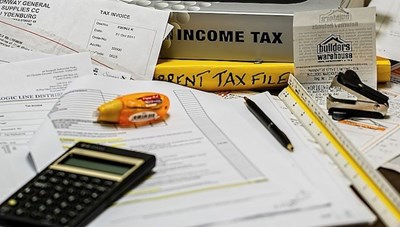
Vermont’s tax system has become unwieldy, overly complex and widely inequitable. This is first and foremost a product of government overreach — the state of Vermont has no incentive to reduce spending or be accountable for wasted millions, and so it only grows bigger, seeking ever more revenue to feed its expansive programs.
Tax policy is tricky, not because of mathematical challenges, but because human beings organize their behaviors around policies in ways that are often unanticipated. Thus, when one well-intentioned tax law is enacted, loopholes will be ferreted out by probing taxpayers, until new provisions must be implemented to plug that undesired outcome. So the more government tries to collect, the more complex and imbalanced tax codes become.
Pretty soon one has a massive tax code and regulations: the U.S. tax code now exceeds 6,550 pages; the IRS Regulations that explain them in detail are many dull pages longer. On top of that, there are an estimated 60,000 pages of tax-related court decisions. My full-time job for years was trying to keep up with all these developments — the IRS Code has more than doubled in volume since I was a tax attorney.
Vermont’s tax laws add an additional layer of complexity to this intricate compliance game (it is a game, between earner-cats and loophole-mice). This game is legal: a fundamental axiom of tax law is that every individual or corporate taxpayer is entitled to take advantage of all beneficial tax provisions (even Donald Trump).
Vermont is regularly ranked as one of the “top ten” worst states for taxes, and was recently rated “not tax-friendly” for middle-class families by Kipplinger’s Report. A recent Vermont “Tax Structure Commission Report” recommended expanding sales taxes to groceries, among other regressive enlargements of complexity and bite. But more, the report recommends creating a tax credit system to redistribute money to low-income taxpayers, itself expected to “consume” 15% of gross receipts in government administration costs.
The more complex tax codes become, the more unfairness, wasted compliance time, and invitation for fraud are increased. Vermont’s tax system has become embarrassingly imbalanced, particularly the assessment of a statewide property tax to fund education. The Tax Structure Commission Report acknowledged this — it just proffered a myriad of ever more complex tax initiatives as “solution.” That’s why federal and state tax codes have only grown over the decades — like tumors, they never shrink without voter irradiation.
Vermont’s tax system is too complex because the state bureaucracy perpetually seeks novel nooks and crannies from which to nibble more pockets, more deeply. This explains why the Tax Structure Commission says nothing about reducing government spending — it is the government, justifying its own continued rulership (tumorship).
The resulting inequities of Vermont’s tax system thus multiply. Taxpayers trying to avoid taxes expose loopholes for government to plug to collect more tax, but there is scant effort by government to plug these exponentially-increasing imbalances between taxpayers, let alone its thirst for ever-increasing revenue. And these imbalances are regressive, meaning they transfer money from poorer citizens to wealthier. (As with net metering, EVs, and many other progressive experiments.)
Consider two common scenarios under Vermont’s bizarre tax laws:
Taxpayer A:
This relatively affluent retiree receives Social Security income of $20,000, and interest income of $4,000, for a very modest total taxable income of $24,000. He owns a home with no mortgage, with a market value of $225,000. Under Vermont’s complex property tax integration, this taxpayer will receive approximately $3,000 in a property tax reduction. Yes, his income is small. But most Vermonters don’t own their homes debt free, and interest earnings of $4,000 in 2020 would require at least $250,000 in cash deposits (likely more). Meanwhile, a married couple with four children, a mortgage, no equity in their residence, and no retirement accounts or savings, who together earn $100,000, will qualify for much less property tax relief on a leveraged house of comparable value.
Taxpayer B:
This state employee plans wisely around those loopholes that never end. She earns wages of $92,500, but elects to divert $5,000 into her retirement account (after all, the state isn’t funding pensions). This reduces her Vermont household income below the $90,000 property tax prebate threshold. She defers tax on the $5,000, while increasing her property tax subsidy by $2,300 (from approximately $1,000 to $3,300) on her $325,000 debt-free home.
These examples are not selected to “vilify the rich” or criticize these taxpayers, who are merely complying with laws they didn’t draft. Nor are these people rich in the sense of the fat cats that Vermont’s money-grubbing bureaucracy seeks to soak — these are upper-middle-income elites who fit neatly in the middle. They can vote for legislators to tax the rich and expand government, and they are perfectly positioned to avoid the costs. This is a moral hazard, and it is growing.
These examples were selected not to condemn taxpayers, but to condemn our tax structures — our tax volume, our tax complexity, our tax excess, our taxation without “equitable” representation — in Vermont. The best path to solve these inequities is not more government intrusion, more pages of code and regulations, more government employees to implement same. The path is to reduce spending, eliminate waste and repeal complex equations that are unfair, inefficient and no longer necessary.
But instead of fixing schools, or pension deficits, or budgetary bloat, Montpelier just keeps “fixing” the tax dice — inequitably. And so in the name of “creating equity,” the cat-and-mouse taxation game just keeps getting more unfair. The cat is too gluttonous, and soon will have devoured all the mice.
Time to get a watchdog.